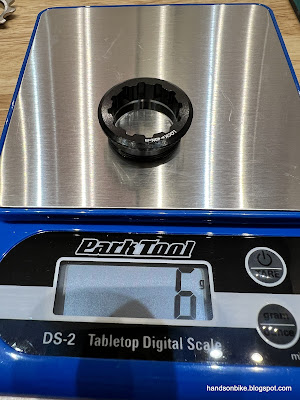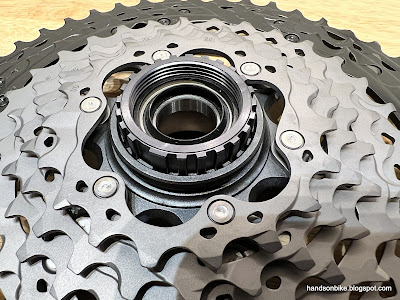I had a chance to borrow a Shimano XTR 12 speed cassette to study, and I decided to make a few comparison posts from this. Usually, my comparison posts on cassettes are based on road cassettes such as Dura-Ace or Ultegra, as they are much more common on my bikes. I do have a few posts comparing MTB cassettes (XTR vs Deore XT vs SLX), or the S-Ride vs SRAM MTB 12 speed cassettes.
Let's take a look at this XTR cassette in detail, and compare it to other cassettes in separate posts.
Shimano XTR CS-M9101 10-51T 12 speed cassette! Also available in 10-45T specification.
All 12 gears shown here. Largest 3 gears are black in colour to help hide the sheer size of the cassette.
This huge 10-51T 12 speed cassette weighs only 370 grams! That is very lightweight for such a big cassette.
The weight of the XTR cassette is on par with the top end SRAM Eagle XX1 and X01 12 speed cassettes. There is a big difference in weight compared to the Deore XT 10-51T 12 speed cassette, as that cassette weighs nearly 100 grams more.
Gear combination: 10-12-14-16-18-21-24-28-33-39-45-51T
Largest 3 sprockets (39-45-51T) are made from aluminium, next 5 sprockets (18-21-24-28-33T) are made from titanium, while the smallest 4 sprockets (10-12-14-16) are made from steel.
The largest 8 sprockets are riveted to the aluminium spider, with only the 4 smallest sprockets being loose parts.
One of the main reason this XTR cassette is able to keep its weight low, is by generous usage of aluminium and titanium sprockets. Only the 4 smallest sprockets are made of steel.
The only other Shimano cassette that uses titanium sprockets is the equally premium Dura-Ace cassette, such as the 12 speed CS-M9200. That is why these cassettes are a lot more expensive (more than twice) than the next grade of Ultegra or Deore XT cassettes, with a correspondingly big difference in weight.
Here is the special aluminium lock ring that is meant for Microspline cassettes. It uses the same lock ring tool as standard HG cassette lock rings.
The Microspline lock ring is longer than usual HG cassette lock rings, and has a smaller thread diameter, so as to reach the freehub body while passing through the small 10T sprocket.
The smallest sprocket on the cassette, the 10T sprocket. Only 9 grams for this steel sprocket!
Lots of tiny splines at the back of the 10T sprocket, which will engage with the next 12T sprocket. Doesn't look very strong, while it is also a pain to manufacture these teeth...
12T steel sprocket, with the splines on top to engage with the 10T sprocket. All the torque from the 10T is transferred to the 12T sprocket through these tiny splines
Here is how the 10T sprocket interfaces with the 12T sprocket.
Another set of tiny splines at the rear of the 12T sprocket, which engages directly with the Microspline freehub body. Made by forging and some machining.
Here is the Microspline freehub body, used by Shimano MTB 12 speed Microspline cassettes. Not to be confused with the Road L2 splines.
Splines at the rear of the 12T sprocket engages with the Microspline splines. Only goes on correctly in one orientation, so make sure you align it properly before tightening the lock ring.
Next loose sprocket is 14T, and it is lighter than the 12T sprocket despite being bigger in diameter, as there is less material.
In between the 14T and 16T sprockets, there is a thin 0.95 mm aluminium spacer.
Although there is already a step forged on the 14T sprocket, this spacer is still needed to provide the correct spacing to the 16T sprocket.
I wondered why not just make the 14T sprocket flat, then add a thicker spacer to create the gap between the 14T and 16T sprocket? Upon closer observation, I realized that the step on the 14T sprocket was to create more space for the 12T sprocket, so that it can engage the Microspline freehub body. Lots of space constraints in that area!
Weight of the flat 16T sprocket. This is also the largest loose sprocket on this cassette, as all the other larger sprockets are riveted to the spider.
The rest of the 8 sprockets are all riveted to the aluminium spider. This construction reduces weight as the sprockets are essentially just a ring.
The 5 titanium sprockets are riveted directly to the spider. Note that the 45T sprocket is riveted to the 39T sprocket with 2 small black rivets on either side of each arm, and also cleverly encloses the spider arm for strength.
Another view of this XTR 10-51T 12 speed cassette. All the rivets are non-magnetic, so they are either titanium or stainless steel.
Front view of the 8 sprockets, with 5 of them being titanium and the other 3 being aluminium.
Gear combination here is 18-21-24-28-33-39-45-51T.
These 8 largest sprockets with aluminium spider weighs just 311 grams.
In order to save weight, the inside of the aluminium spider is actually machined away, and only the top and bottom of the spider has the splines that engage with the Microspline freehub body.
Here is how the cassette fits onto the freehub body. Not much room left for the 4 smallest sprockets!
With the 16T and 14T sprockets added on. Despite the 14T sprocket having a step down, there is still little engagement between the 12T sprocket and the Microspline freehub body.
Here is the Microspline lock ring, with a long body to reach into the threads of the Microspline freehub body.
This cassette is packaged with a black cassette holder that has a different spline pattern to hold Microspline sprockets.
Very interesting close up look at the XTR 10-51T 12 speed cassette, with lots of differences with standard HG cassettes, in order to have a smaller 10T sprocket. In future posts, I will compare this cassette with the older 11 speed XTR cassette and also the road 12 speed cassette.






























No comments:
Post a Comment
Every comment is moderated before publishing due to spam bots. If you don't see your comment yet, it is likely that it is currently being reviewed. Thank you for your patience!